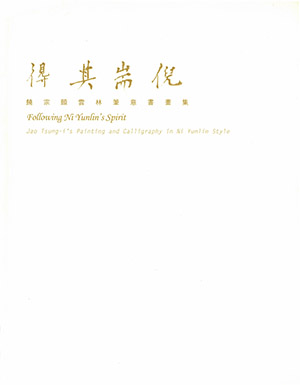 Back
Back

Year: 2009
Editor: Dr Tang Wai Hung
Press: Jao Tsung-i Petite Ecole, University of Hong Kong;Hong Kong
Prologue
Professor Jao Tsung-i has always suggested studying the source of both art and academic creations. For this reason, he believes that for beginners, especially in landscape paintings, should start from imitating the paintings of the Four Masters of the Yuan Dynasty; and then to study the vigorous painting style of the Song Dynasty and the untrammeled and sturdy spirits of the Masters in the late Ming Dynasty. Through imitating the Four Masters of the Yuan Dynasty, he derives the essence from them--the simplicity and savor of Huang Gongwang, the powerful strokes of Wu Zhen, the refinement of Wang Meng, and the purity and peace of Ni Yunlin; among the Four Masters, Professor Jao is especially proficient in expressing Ni Yunlin’s elegancy. Hence, he has been called “Today’s Yunlin” since the 60’s of the 20th century.
Professor Jao had taught in the University of Hong Kong in the 50’s, practicing painting and calligraphy during his leisure time. He had looked into Ni Yunlin’s paintings and calligraphies continuously because of the admiration for Ni’s superior artistry and virtuousness. People usually consider Ni Yunlin’s paintings simple and sketchy, but only few of them are able to get into the complexity of composition through simple strokes. Even Shen Shitian, Wen Hengshan of the Ming Dynasty; Yun Nantian, Shi Tao of the Qing Dynasty, and Zhang Daqian, Pu Xinyu in the modern times couldn’t surpass him. Therefore, it was said that when Shen Shitian imitated Ni Yunlin, his master would always think that he overdid it. And Shi Tao once sighed and said, “People always have a misunderstanding that painting in simple composition is the way of Ni Yunlin.” On the contrary, when Professor Jao portrays Ni Yunlin’s paintings, we can see the richness from the simplicity, and complexity from the roughness as well as the varieties of the use of ink and color. Professor Jao uses the running-cursive script style of the Jin Dynasty, therefore the strokes are moderate and able to seem like multi-lined even with only one stroke. In recent years, Professor Jao has further written in cursive-seal script to paint in Ni Yunlin’s style, which can make the work look tactful and sophisticated. And hence, Professor Jao’s skills even transcend Wang Fu, Qi Luejia, Jian Jiang, Shi Tao of the late Ming Dynasty, and Wang Hui, Wang Yuanqi of the Qing Dynasty, opening a new direction for the techniques of painting in Ni Yunlin’s style.
Among the Masters of the Yuan Dynasty, Ni Yunlin’s calligraphy is unique, and its manner would never be confined by Zhao Mengfu or Xianyu Shu. The source of his calligraphy can be traced back to the combination of Ouyang Xun and Chu Suiliang of the Tang period, and Professor Jao has also delved into the styles of the two Masters. And therefore, he can easily express Ni Yunlin’s calligraphy style, obtaining its essence but at the same time, without being restrained.
Hong Kong Arts Development Council awarded an Honorary Award to Professor Jao in this April. To go with this grand event, Jao Tsung-i Petite Ecole holds the exhibition “Following Ni Yunlin’s Spirit–Jao Tsung-i’s Painting and Calligraphy in Ni Yunlin Style”, whose main purpose is to see Professor Jao’s idea of “There must be origins in both academic and art works”, and to show Professor Jao’s ability in absorbing the nutrients of the previous masters and further glorify and expand it.
We do believe that we can percept Professor Jao’s superb achievement in art through this exhibition.
Tang Wai Hung
March, 2009
